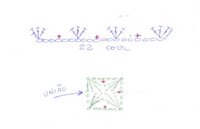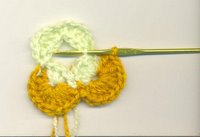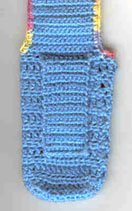Four-Triangles Square
 A square for math-loving crocheters, LOL
A square for math-loving crocheters, LOLI've created this square for a granny exchange in 2002. It allows for many variations. You can do it in single crochet, as in the pattern below. You can also make it in tunisian (afghan) stitch. You even don’t need a special hook; for so few stitches you can use your regular crochet hook.
Usually I make this square with 3 colors: one varigated, two solids. Colors A, B and C. The samples were made with Brazilian Familia acrylic yarn (sport weight??? It’s a tad thinner than worsted weight) and a 4-mm hook (F? G? I will never learn the American letter system.)
With color A, ch 12.
1st row: Beginning in the second ch from hook, make 11 sc. Ch 1, turn.
2nd row: Sc, inserting the hook through the back loop. Make 9 sc, 1 decrease (insert hook in the first st, pull a loop; insert hook in the second st, pull another hook; yo, pull through the three loops on hook) (total = 10 stitches). Ch 1, turn the work.
3rd row: 1 dec, 8 sc (work always in the back loop, in all rows) (total = 9 st). Ch 1, turn.
4th row: 7 sc, 1 dec (total = 8 st). Ch 1, turn.
5th row: 1 dec, 6 sc (total = 7 st). Ch 1, turn.
6th row: 5 sc, 1 dec (total = 6 st). Ch 1, turn.
7th row: 1 dec, 4 sc (total = 5 st). Ch 1, turn.
8th row: 3 sc, 1 dec (total = 4 st). Ch 1, turn.
9th row: 1 dec, 2 sc (total = 3 st). Ch 1, turn.
10th row: 1 sc, 1 dec (total = 2 st). Ch 1, turn.
11th row: 1 dec; finish the dec with color B. Ch 1.
Now you’ll work in the short side of the triangle. Make 11 sc with Color B - one sc in each row of the first triangle. Ch 1, turn.
Repeat from 2nd to 11th row to make the second triangle. Take care to make all decreases at the same side - the decreases are always at the longer sides of the triangles; look at the pictures.
Take care also to keep the Color A with you, crossing it at the end of each other row, so it will be at the right place when you finish the second triangle without the fuss of cutting yarn, finishing it off and tying it again.
Finish the 11th-row decrease with color A and repeat all the process again to make the third triangle. Keep Color B with you, crossing it with Color A at the end of each other row, etc.
Finish the 11th-row decrease of the third triangle with color B.
Now, in the fourth and last triangle, you won’t need to take Color A with you; cut it and finish it off.
As in the other 3 triangles, make 1 sc at each row of the previous triangle; but when you reach the 11th sc, before finishing it insert hook in the base chain of the corresponding stitch of the first triangle, pull a loop and finish the 11th sc. Make a slip stitch in the next base chain of the first triangle, turn. This way you “sew” the fourth triangle to the first one as you go.
You’ll make this last triangle the same way you made the other three, but will always end the odd rows inserting the hook in the base chain of the first triangle, pulling a loop and finishing your last sc; and will begin all the even rows with a slip stitch in the next base chain of the first triangle.
When you finish off the last triangle, the center of your square will be ready. Now, tie Color C in any corner; you’ll make 16 sc in each side of the square, with 2 ch at the corners.
Next row: dc; make 2 dc, 1 ch, 2 dc in each corner.
If the square still doesn’t measures 6”, make new sc or dc rows as needed.

If you follow the same process, you can make the triangles with any sc-related stitch you want. You can even use afghan stitch; since there are few stitches, you won’t need an afghan hook to do that. The violet and off-white square below uses the afghan stitch. Take a look. You can also make the framing rows in camel crochet, to get a nice “puffy” look; I used this stitch in the first sample.
Enjoy yourself.






























